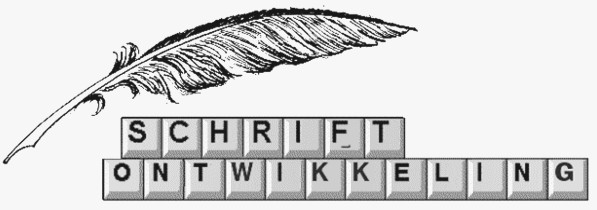Articles in English
“Children are not so much restricted by limited possibilities, but rather by the expectations of their educators.”
Handwriting study on graphomotor skills of young children
In Octobre 2005 an article of the Script Development Foundation (Stichting Schriftontwikkeling) appeared following on an study on the opportunities of distal graphomotor skills. A different approach to graphomotor skills in young children creates new options for helping children of all ages to improve their handwriting skills. The conclusions of this study will give a totally new view on the possibilities of young children's distal graphomotor tasks. The conclusions will overthrow the present view on this subject. You can download an English version of this article here (click on the image below)!
A different approach to graphomotor skills in young children creates new options for helping children of all ages to improve their handwriting skills. The conclusions of this study will give a totally new view on the possibilities of young children's distal graphomotor tasks. The conclusions will overthrow the present view on this subject. You can download an English version of this article here (click on the image below)!
Opportunities for distal graphomotor skills If you want to use the exercices, offered in the article, please send us an e-mail! Please send us your comments and/or experiences: info@schriftontwikkeling.nl If you know people in countries outside the Netherlands, who might be interested in and concerned with handwriting development, please send them this ‘link’ or, if you have a website on this subject, please place this link on your website: www.schriftontwikkeling.nl N E W You can download a very interesting article here. It shows the relation between calligraphy and the remediation of handwriting!
Another interesting article concerning an unsuccessful official handwriting quality research, once again successfuly executed by Stichting Schriftontwikkeling:
Zoomed in on the exercise:
POINTERS FOR HANDWRITING TRAININGThe vision of the Script Development Foundation (Stichting Schriftontwikkeling) regarding the training of handwriting is founded on the following features. They are the basic elements for learning and supporting the writing by hand.
- Writing by hand is a very important aspect in school. Pupils use handwriting for at least 30-60% of their time. Therefore, their handwriting should be functional.
- In addition to arithmetic, grammar and reading, handwriting is a ‘condition for learning’ or a basic skill.
- The ability to write by hand is an important element of the child’s feeling of competence.
- A readable and a (not too) smooth handwriting requires and supports the self-discipline of the writer.
FUNCTIONAL
Children have to do a great deal of writing in primary school and, although the use of computers is growing, writing by hand remains essential. Because of the utilisation of computers it is important to exercise handwriting even more intense and with more awareness. This exercise must be focused on those applications for which writing by hand is used most, namely: noting down of thoughts, answering questions, making an inventory of ideas, filling out sheets, working out tests, writing notes in class or out, etc. Also under those conditions whereby the use of a keyboard is not practical or possible, for instance when pupils have to take notes outside the classroom or outside the building.
FEELING OF COMPETENCE
A child’s feeling of competence is related to its feeling of security. When a child knows what it is able to, and because it discovers that this can be influenced, its feeling of competence is boosted. It is therefore important that work is done to improve the child’s handwriting. Particularly, a lot of effort needs to be allocated to this activity during the final years in primary school. Too often handwriting is seen as a ‘personal thing’ that is hard to change and, therefore, develops into ‘unreadable’ in many instances.
SELF DISCIPLINE
This concept has been somewhat neglected by pedagogy and education lately, but children still benefit from learning how to set limits, particularly for themselves. Self-discipline is an indispensable element to master motorial skills. Music teachers know this too well. However, writing is an essential prerequisite for everybody and, when acquiring this skill, additional attention for the requirements of a proper handwriting is therefore vital. Accordingly every child needs to incorporate these requirements, or handwriting criteria, into its own handwriting and should be challenged to do so. Throughout handwriting training the child has to be made aware of these criteria specifically during the period subsequent to group 4 (Netherlands) in primary school (age of 7). During this phase, also named the prolonged writing period, one normally concentrates on automation of the handwriting. It is important that attention is given to the training of handwriting on a regular basis, but not too long per instance. The law of Jost holds here too: better often short than sometimes long.
READABILITY
From group 5 onwards the norm ‘writing neatly’ cannot be held anymore because it does not provide sufficient feedback to the child. ‘Neat’ or ‘polished’ are subjective terms that provide little information. That is clearly noticeable by looking at the handwriting of these children, and is confirmed by the experience of their teachers. The only remaining action is to keep repeating that their handwriting must be ‘neat’, as indicated in the figure. Readability almost unanimously is regarded as the minimum requirement. However, also readability is a subjective concept that, moreover, strongly depends on the context of the sentence or story it forms a part of. A simple recognition of each character without its context, however, should be the minimum requirement for readability. Only then the child is able to shape the formulae used for mathematics, chemistry and physics when in secondary school. The Script Development Foundation ascertains that ‘readability’ is not the standard for a proper handwriting development. It uses a different standard, being ‘reading comfort’ (convenience of reading) that requires a stable and undisturbed x-height zone and a regular character and word spacing in addition to a proper shape of the characters used. You may read a build explanation of this approach in the article: ‘A better handwriting by less training’.
 A different approach to graphomotor skills in young children creates new options for helping children of all ages to improve their handwriting skills. The conclusions of this study will give a totally new view on the possibilities of young children's distal graphomotor tasks. The conclusions will overthrow the present view on this subject. You can download an English version of this article here (click on the image below)!
A different approach to graphomotor skills in young children creates new options for helping children of all ages to improve their handwriting skills. The conclusions of this study will give a totally new view on the possibilities of young children's distal graphomotor tasks. The conclusions will overthrow the present view on this subject. You can download an English version of this article here (click on the image below)!






